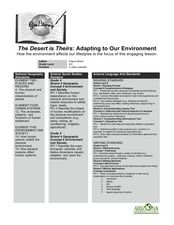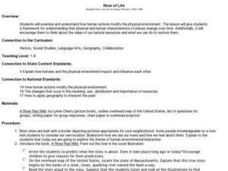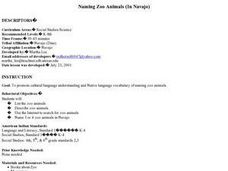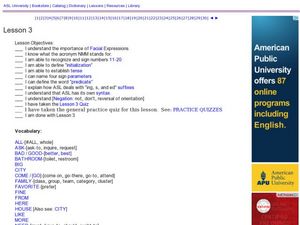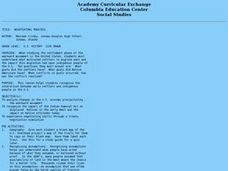National Endowment for the Humanities
Colonizing the Bay
Eleventh graders review the goals of John Winthrop. In this American History lesson, 11th graders read Winthrop's speech and summarize his key points. Students predict the possibilities for success and failure in the Massachusetts Bay...
Curated OER
Territory and Statehood of Iowa
Fifth graders recognize the steps to create a territory, a district and a state. In this Iowa lesson, 5th graders discuss the three capitals and their importance. Students recognize the key people in the development of Iowa. Students...
Curated OER
Making a Colorado Brochure
Students create brochures reflecting the state of Colorado. In groups, they write about tourist attractions, important people, major cities, and statistical information. After writing, they create their brochure importing clip art and...
Curated OER
The Desert is Theirs: Adapting to Our Environment
Young scholars determine how animals and people adapt to the desert environment. In this desert lesson, students review vocabulary about the desert and how humans have to make changes to accommodate their environments. They listen to and...
Curated OER
Oregon City: A Convergence of Endings
Students describe the activities that occurred in the Willamette Valley before the establishment of the Oregon Trail and agricultural settlement and explain the impact that American settlement had on the landscape and native groups who...
Curated OER
Baga Drum
Students examine a Baga Drum in order to explore the history of the Baga people of West Africa. In this art history lesson, students recognize figures used in Baga Drum design that represent aspects of Baga culture. They also design and...
Curated OER
Lone Pine- Cultural Fire Management
Fourth graders investigate the concept of fire and how it was used by the Native Americans. The lesson has sufficient background information for the teacher to establish historical context. Students summarize the nine uses for fire to...
Curated OER
Where Indians and Bison Meet
Fifth graders examine a transparency of the Pre-2004 Monticello Nickel and compare it to the American Bison Nickel. They research Native American tribes and discover why the bison was so important to them. They create products showing...
Curated OER
The Turn of the Nineteenth Century: Lifestyles and Cultures
Student reflect on the differences between the life of children in the early
nineteenth century and their lives in the present. They demonstrate these differences by creating a drawing of "then and now." In addition, they create a...
Curated OER
Environment: River of Life
Students assess the impact of human activity on the environment. After reading the book, "A River Ran Wild," they role-play and discuss how people changed the river. Students write stories about living along a river from the point of...
Curated OER
California Indians
Fourth graders discuss the major nations of California Indians, their geographic distribution, economic activities, legends and religious beliefs. They describe the function of Spanish missions and the influence of Catholicism. In...
Curated OER
Naming Zoo Animals (In Navajo)
Students investigate zoo animals and name various zoo animals in Navajo. They take a field trip to the zoo, take digital pictures of various animals, conduct research, and name each animal in Navajo.
Curated OER
Conflict And Cooperation
Fourth graders engage in a study of how cultural indian tribal groups cooperated or had conflicts amongst themselves. The research is conducted using a variety of resources and students make connections to their own culture. The skills...
Curated OER
We the People (Cultural Research)
Fourth graders conduct cultural research, collect oral histories using tape recorders and cameras, and share their ancestral heritage with classmates through family heirlooms and ethnic foods.
Curated OER
Cowboy Tourism
Students disucss the role the tourist industry played in popular perceptions of cowboys and Indians. They discuss the image of cowboys, as it is presented in fashion and contemporary advertisements. Students read about a town in Montana...
Curated OER
The Importance of Buffalo Culture to Blackfeet Indians
Students examine importance of buffalo in culture of Blackfeet Indians, and explore types of technology used by Indians to kill large numbers of buffalo. Students research transition of Blackfeet from subsistence economy to capitalist...
National First Ladies' Library
Will the Real Pocahontas Please Stand Up?
Learners explore the life of Pocahontas and Powhatan Indians. After studying information on a given website, students compare and contrast what they read about Pocahontas and what they previously thought of her. They explore life in a...
Curated OER
ASL: Lesson 3
The ASL lessons from lifeprint are amazing, but can be complicated. While this lesson is perfect for those needing to learn or teach ASL to the deaf community, it could also provide a valuable communication tool. This resource features...
Curated OER
Exploring a New World
Fifth graders create a PowerPoint presentation about Christopher Columbus. The integration of technology helps them to be engaged in the subject matter. The basis for the information in the presentation is for students to answer some...
Curated OER
Negotiating Treaties
Eleventh graders recognize the interaction between early settlers and indigenous people in the U.S. They recognize the impact of the Indian Removal Act on displaced Natives in the early West and the impact on Native attitudes today.
Curated OER
The Indian Wars Continue
Students focus on three incidents: the Chiapas uprising, the occupation of Alcatraz and the occupation and subsequent battle of the Wounded Knee reservation.
Curated OER
A Day in the Life
Students examine the various roles people played on the 19th century Texas frontier. Using the internet, they get to know five residents of Fort Griffin and take notes on their characteristics. They choose one person to research more...
Curated OER
Money Talks
Students move from fact finding to interpretation as they examine paper money from the time of the American Revolution. In the final exercise, they use the issue dates of the bills to construct a chronology of political changes during...





